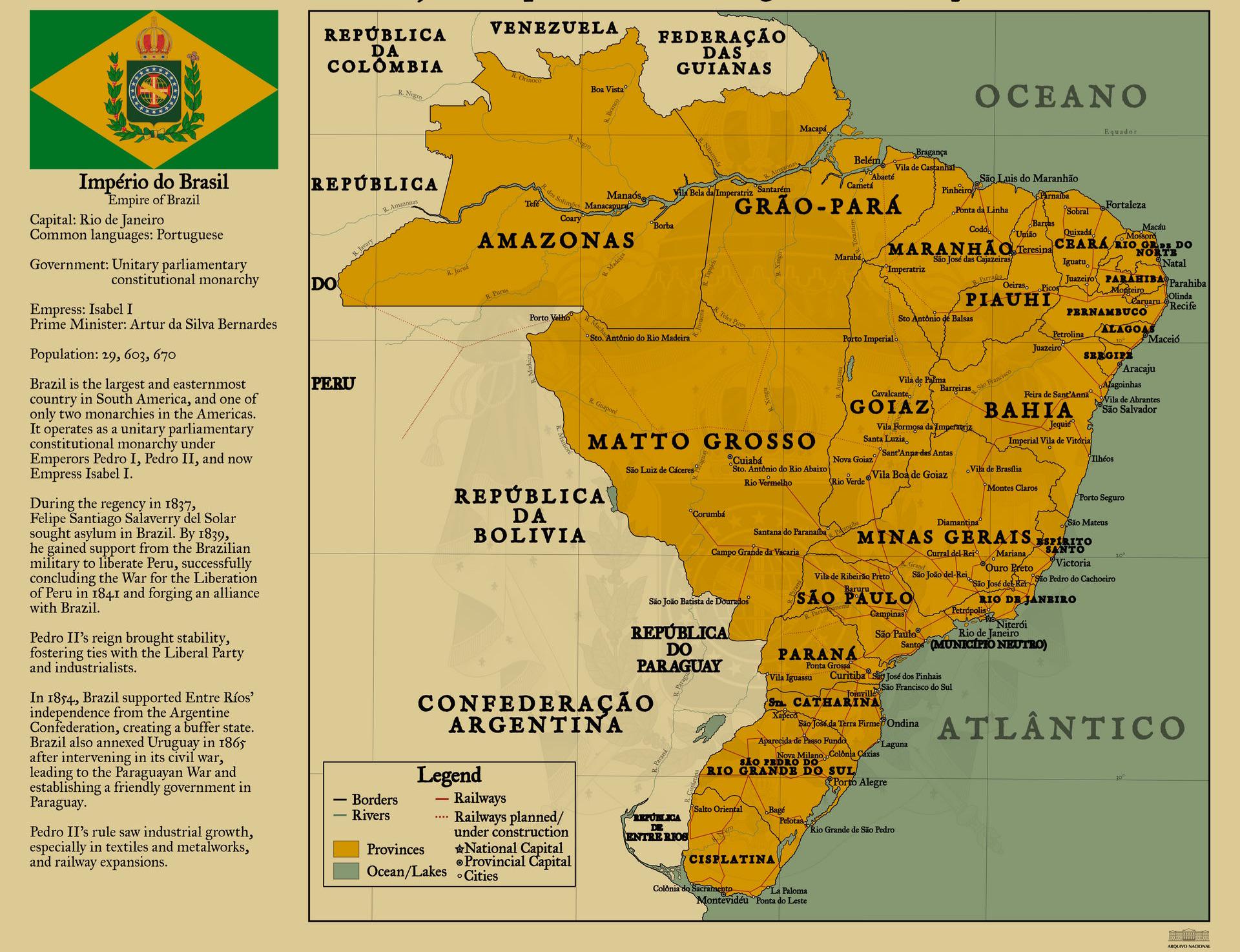Empire of Brazil Map, Circa 1822


David Chen
Data Visualization Specialist
David Chen is an expert in transforming complex geographic datasets into compelling visual narratives. He combines his background in computer science ...
Geographic Analysis
What This Map Shows
The "Empire of Brazil, circa 1822" map presents a comprehensive visualization of Brazil during a pivotal moment in its history. This map captures the geographical boundaries of the Brazilian Empire shortly after its independence from Portugal in 1822. At this time, the empire encompassed a vast territory that included present-day Brazil, Paraguay, and Uruguay, showcasing the political landscape of the region as it was seen over two centuries ago.
Interestingly, this map illustrates how Uruguay was regarded as a state of the Brazilian Empire, a fact often overlooked in contemporary discussions of South American history. Furthermore, it’s essential to note that the territory of Acre, now a well-known Brazilian state, was not yet part of Brazil in 1822. This map serves as a snapshot of the time, highlighting the fluidity of borders and the evolving nature of national identities.
Deep Dive into the Empire of Brazil
The Empire of Brazil, established in 1822, marked a significant transformation in Latin American history. Following centuries of Portuguese colonization, Brazil's independence signified not just a political shift but also a cultural and economic reawakening. This vast empire covered a range of geographical features, from the Amazon rainforest to the expansive coastal lines, influencing not only its inhabitants but also international trade routes.
Geographically, Brazil's diverse landscapes include the rugged mountains of the southeast, the fertile plains of the central region, and the dense jungles of the north. These varied terrains created unique ecological zones that supported diverse cultures and economies. For instance, the coastal areas relied heavily on agriculture and trade, while the interior regions began to develop an economy around rubber and other natural resources. The map implies a sense of unity in diversity, showcasing how different regions contributed to the overall structure of the empire.
Population dynamics during this time were equally fascinating. The Empire of Brazil was home to a mix of indigenous peoples, enslaved Africans, and European settlers. This blend of cultures gave rise to a rich tapestry of languages, traditions, and practices. The demographic distribution was heavily influenced by the geography; coastal cities like Rio de Janeiro and Salvador became bustling urban centers, while the interior remained sparsely populated for many years.
The political landscape was also dynamic, with tensions between regional powers and the central government. The inclusion of Uruguay as a state of the Empire reflects the complexities of governance during this period. However, as history progressed, Uruguay would eventually assert its independence, highlighting the fragility of political boundaries and the ever-changing nature of governance.
Regional Analysis
Breaking down the Empire of Brazil by regions offers intriguing insights into the socio-political and economic disparities of the time. In the northeast, states like Bahia and Pernambuco were vital for sugar production, contributing significantly to the empire's wealth. In contrast, the southern provinces, such as Rio Grande do Sul, were more focused on cattle ranching, illustrating the regional economic variations based on geographical advantages.
The southeastern region, which included the capital, Rio de Janeiro, became a melting pot of cultures and an economic powerhouse. The influx of European immigrants during the following decades would further transform this area, making it a focal point for trade and industry.
Interestingly, the Amazon region, shown in the northern part of the map, remained largely unexplored and underutilized during this period. The rich biodiversity and vast resources were not yet fully harnessed, leaving a significant impact on Brazil's economic development in the years to come. This disparity emphasizes the regional differences in development and resource utilization within the empire.
Significance and Impact
Understanding the geography of the Empire of Brazil in 1822 provides crucial context for contemporary Brazil and its historical evolution. The dynamics of territorial control, population, and regional economies during this period laid the groundwork for modern Brazil's societal structures and political landscape. The complexities of governance, as illustrated by the inclusion of Uruguay and the absence of Acre, foreshadowed the ongoing challenges faced by Brazil in establishing a cohesive national identity.
Today, Brazil stands as a testament to the historical shifts that have shaped its borders and culture. The lessons from this period resonate in current discussions about national unity, regional disparities, and the importance of preserving diverse cultural identities. As we analyze contemporary issues, it becomes clear that the past still lingers in the geographical and cultural fabric of Brazil.
In conclusion, this map of the Empire of Brazil circa 1822 is not just a historical artifact; it is a gateway to understanding the multifaceted nature of Brazilian identity and the evolution of one of the largest countries in South America. As we map out the future, reflecting on the past helps us navigate the complexities of regional relationships and national identity in an increasingly interconnected world.
Visualization Details
- Published
- September 18, 2025
- Views
- 56
Comments
Loading comments...